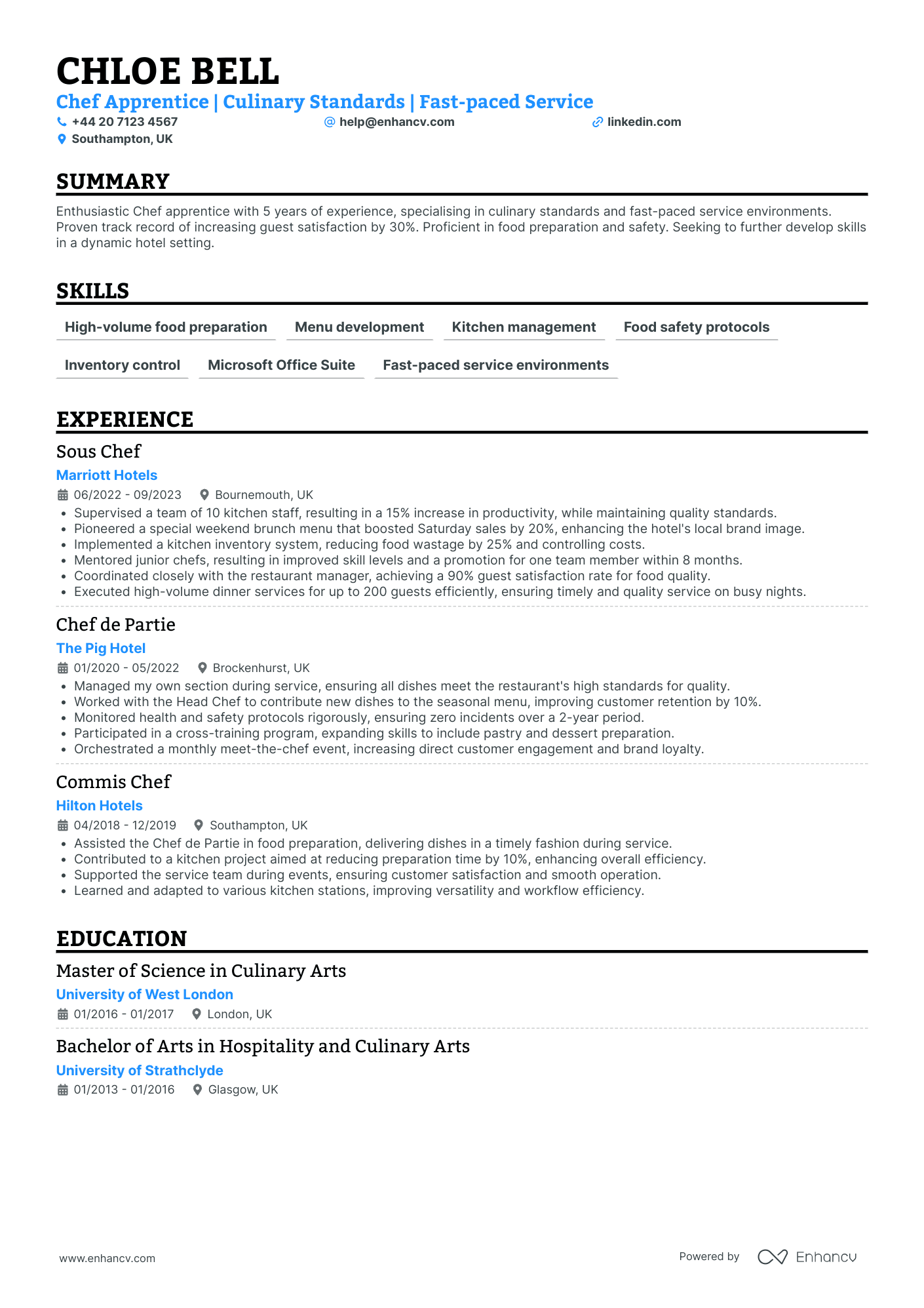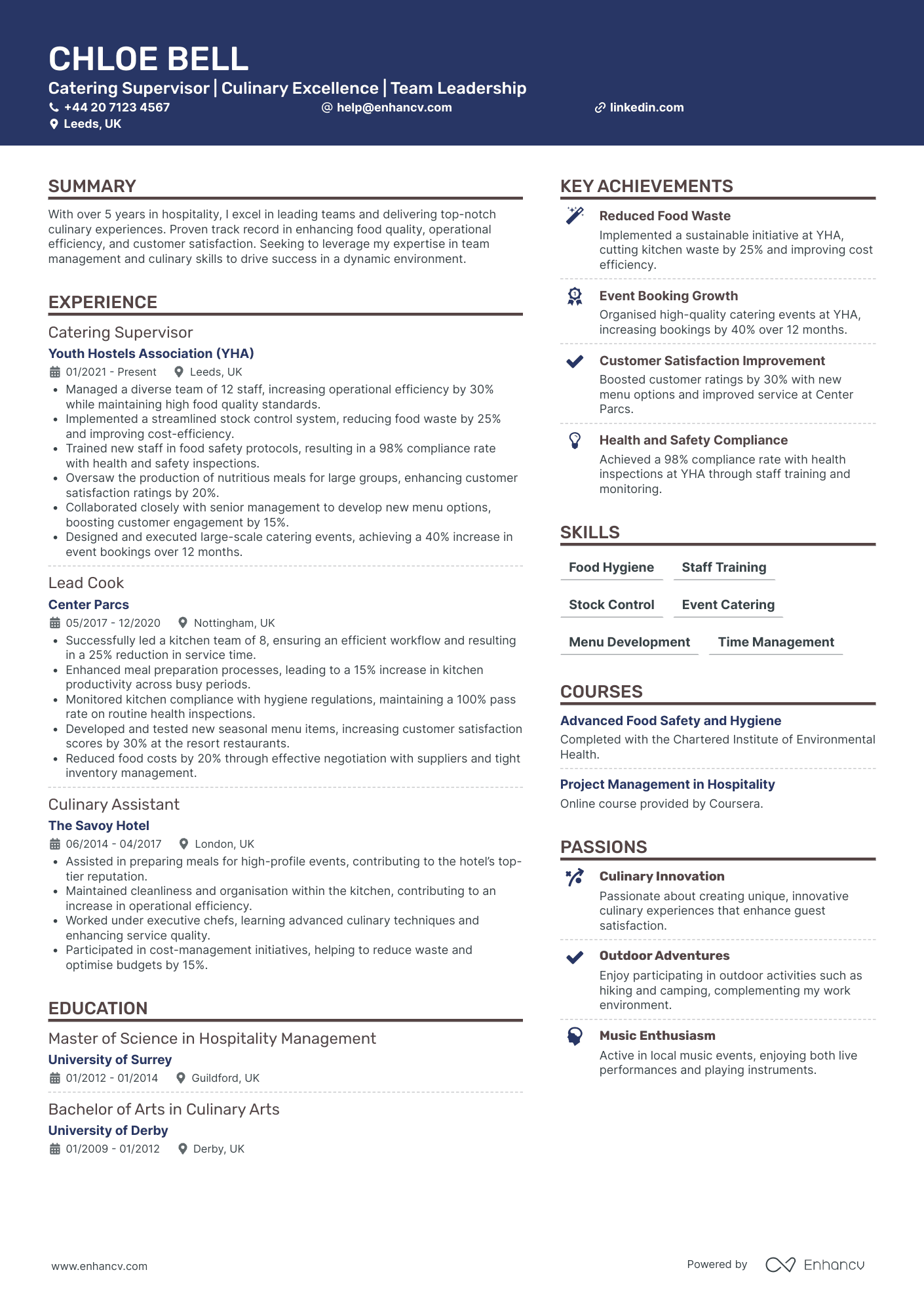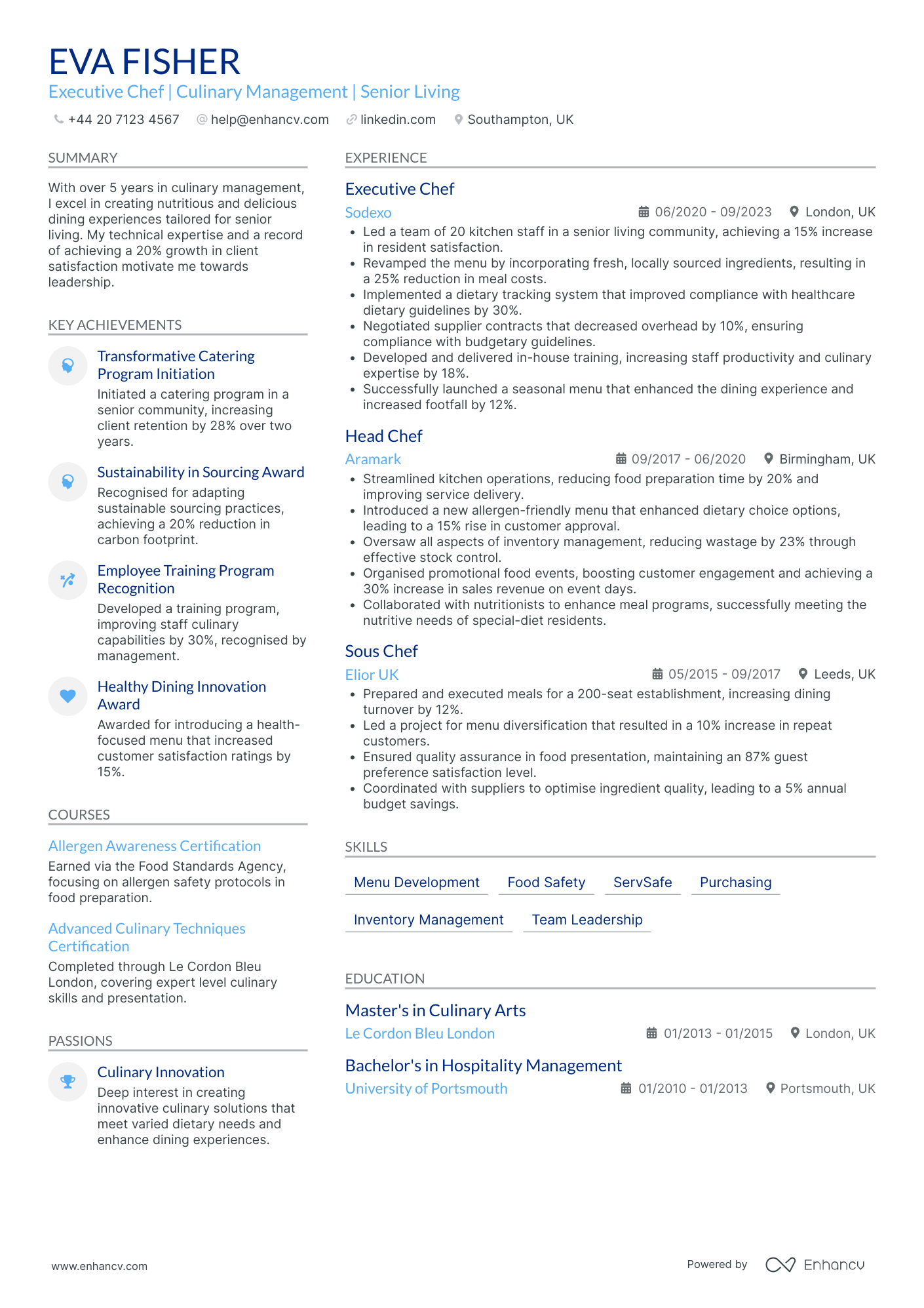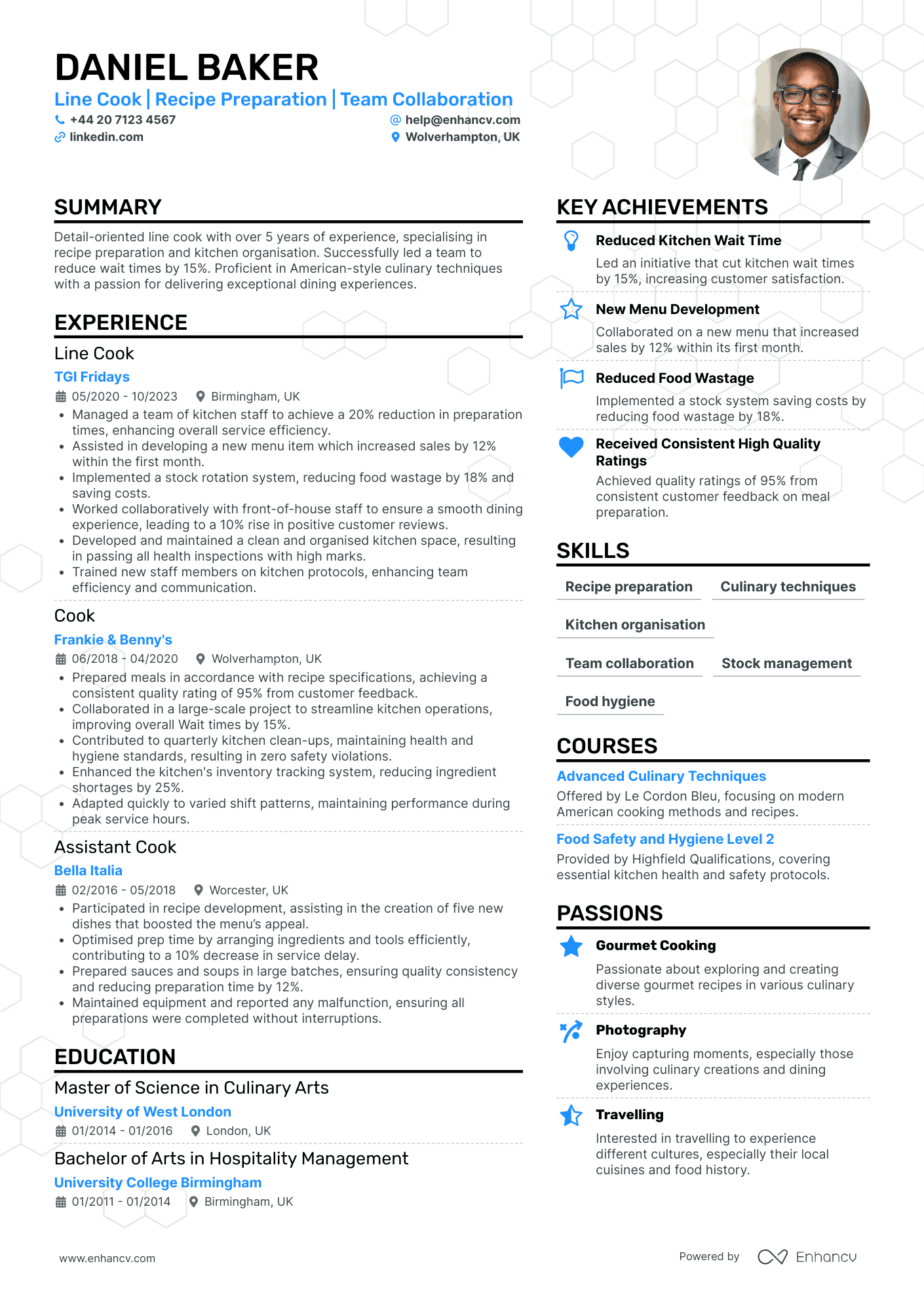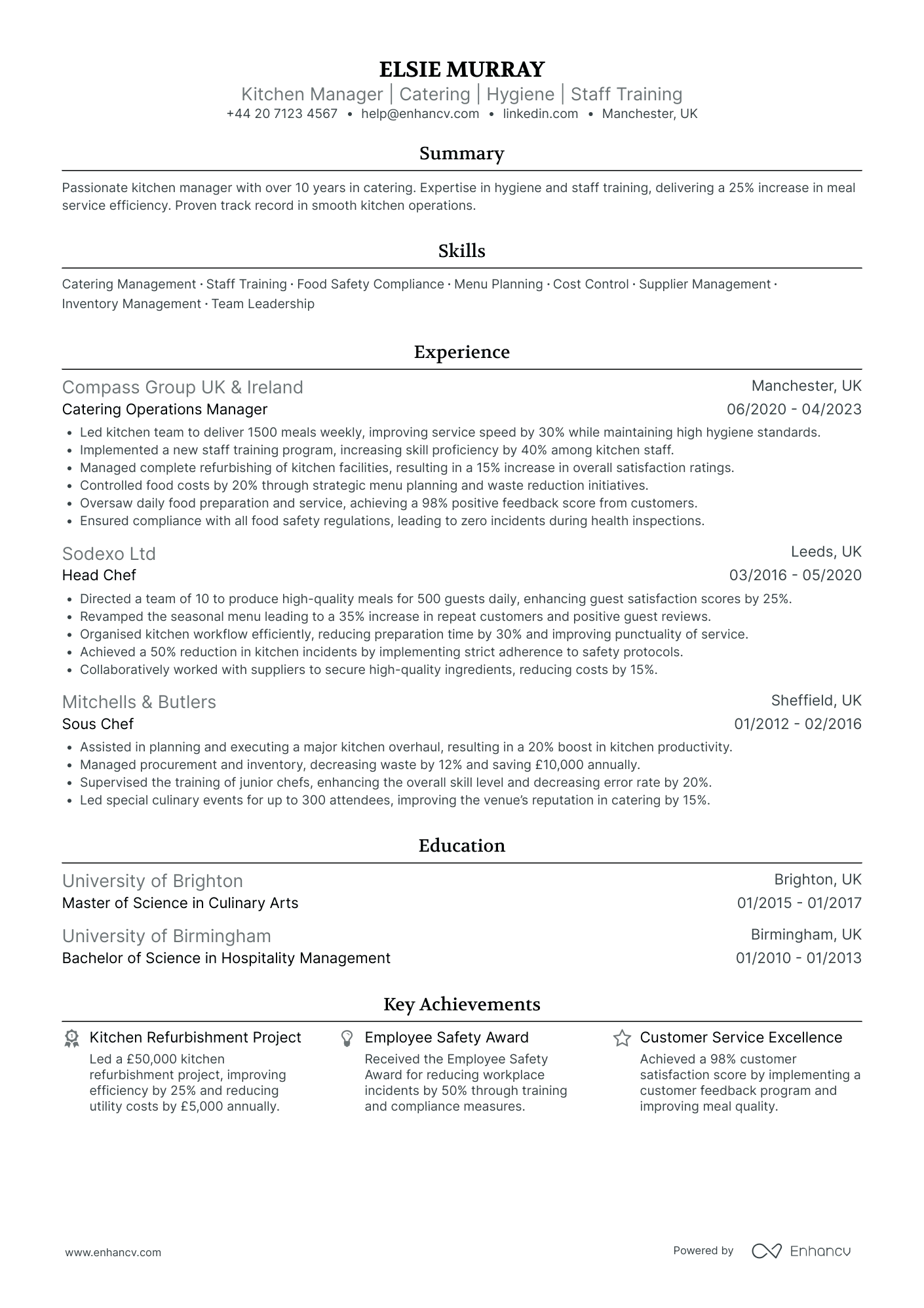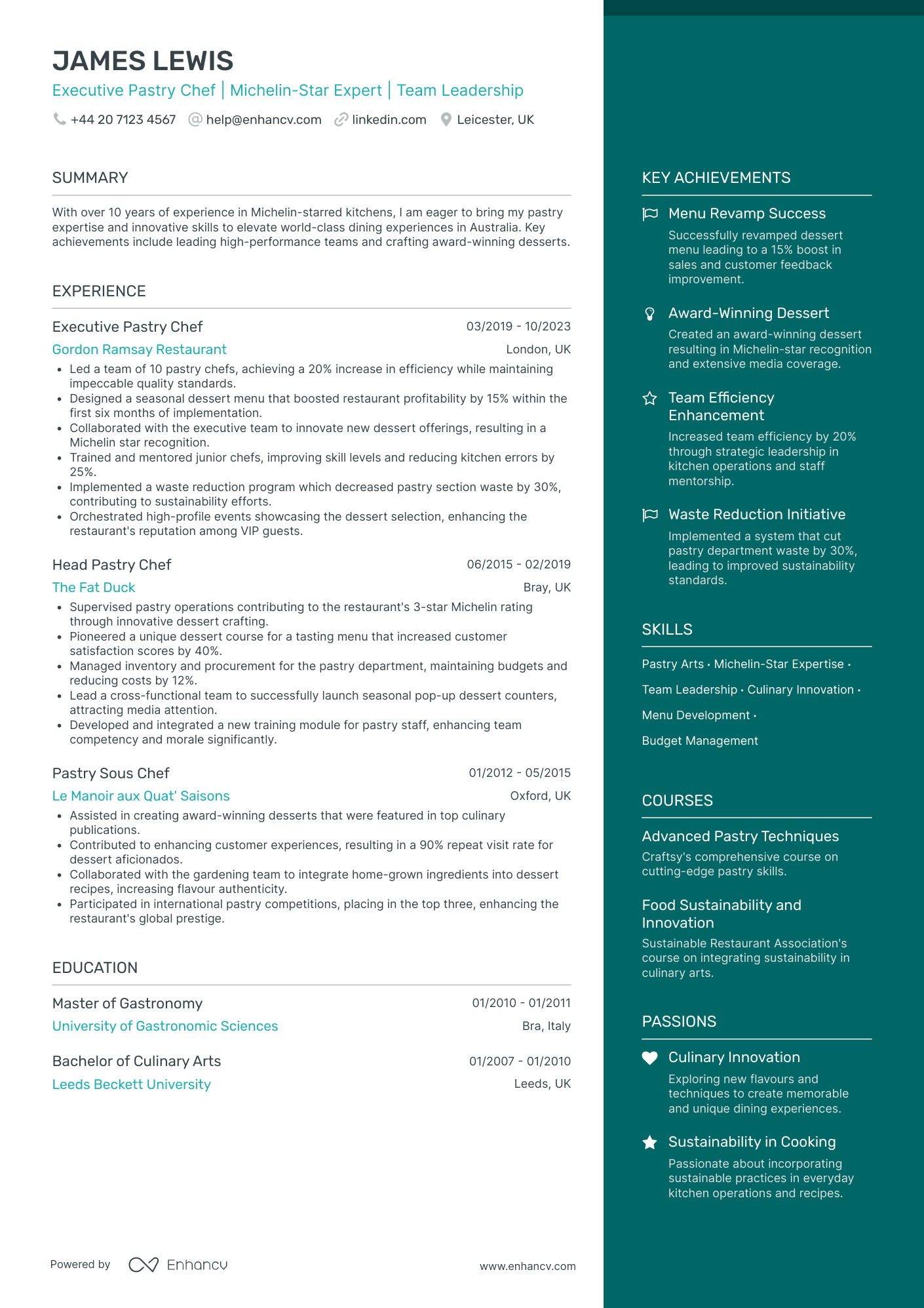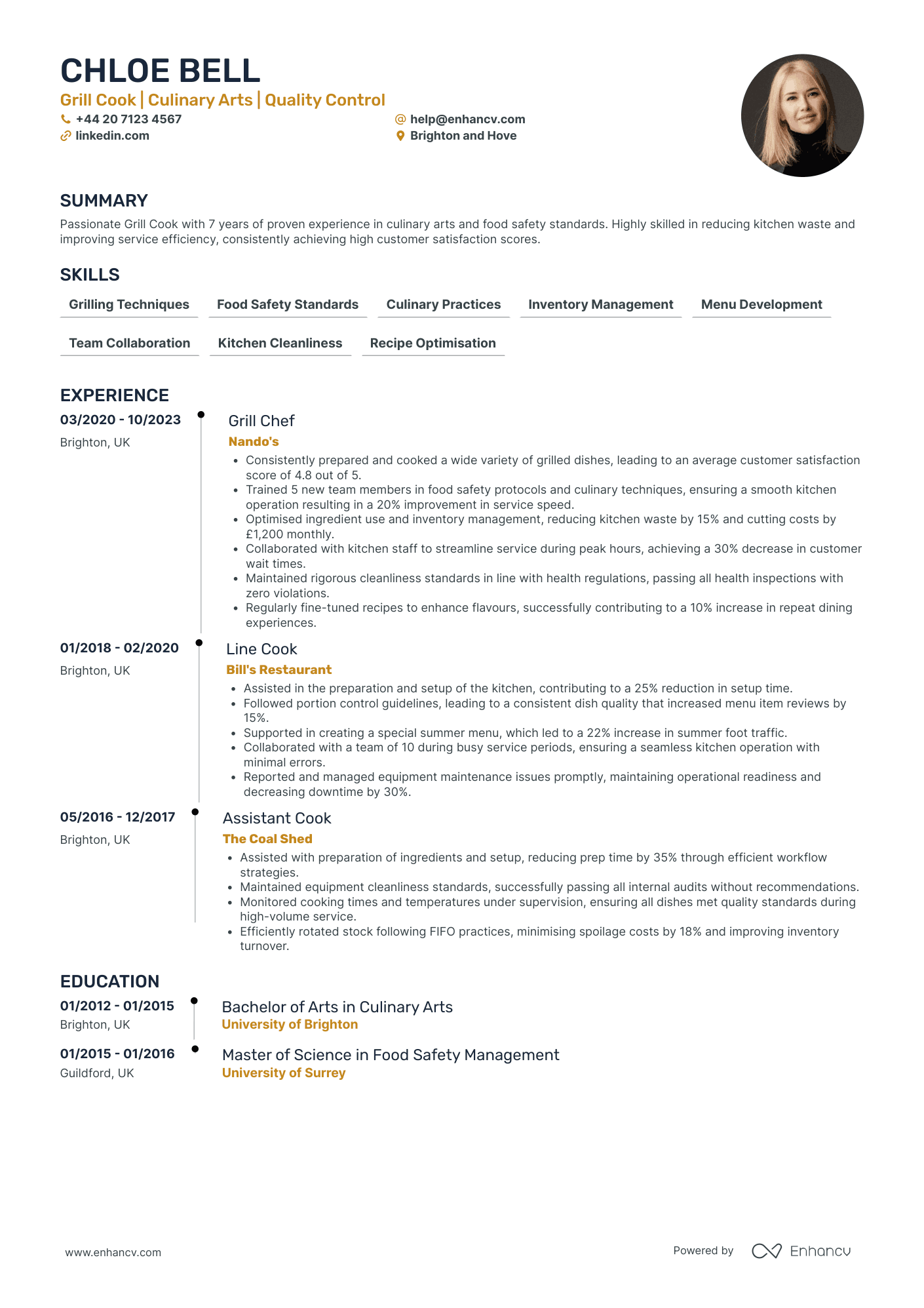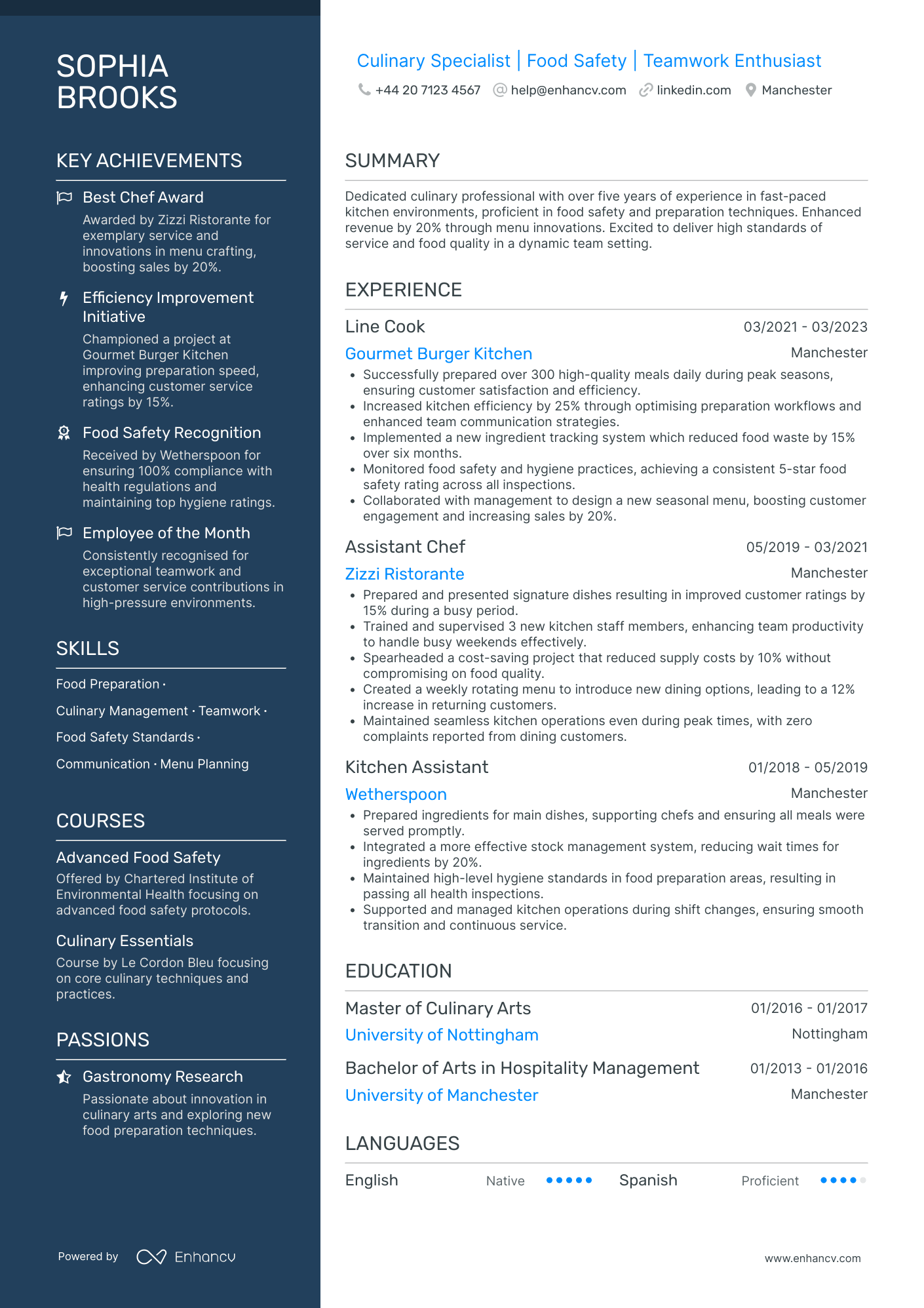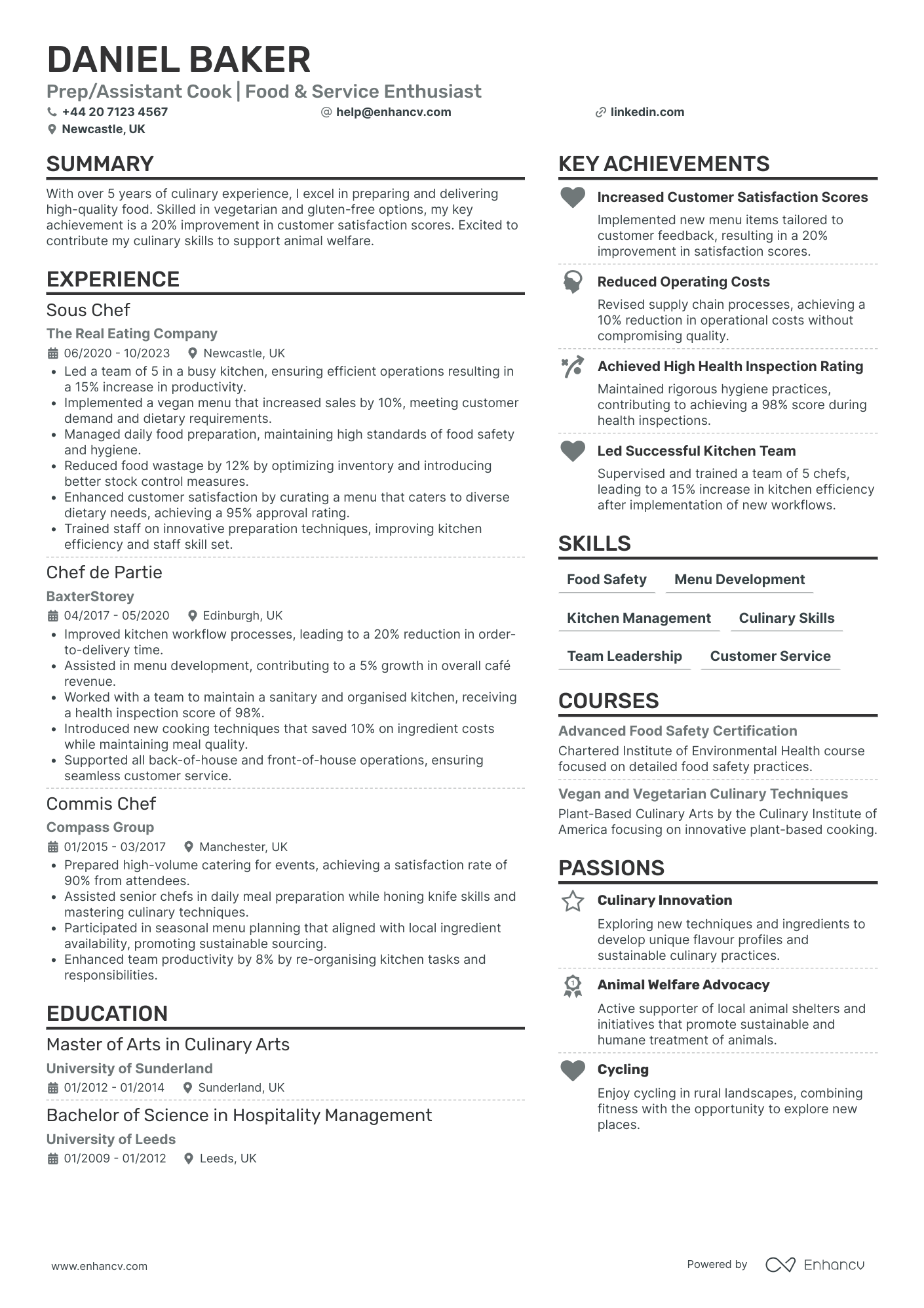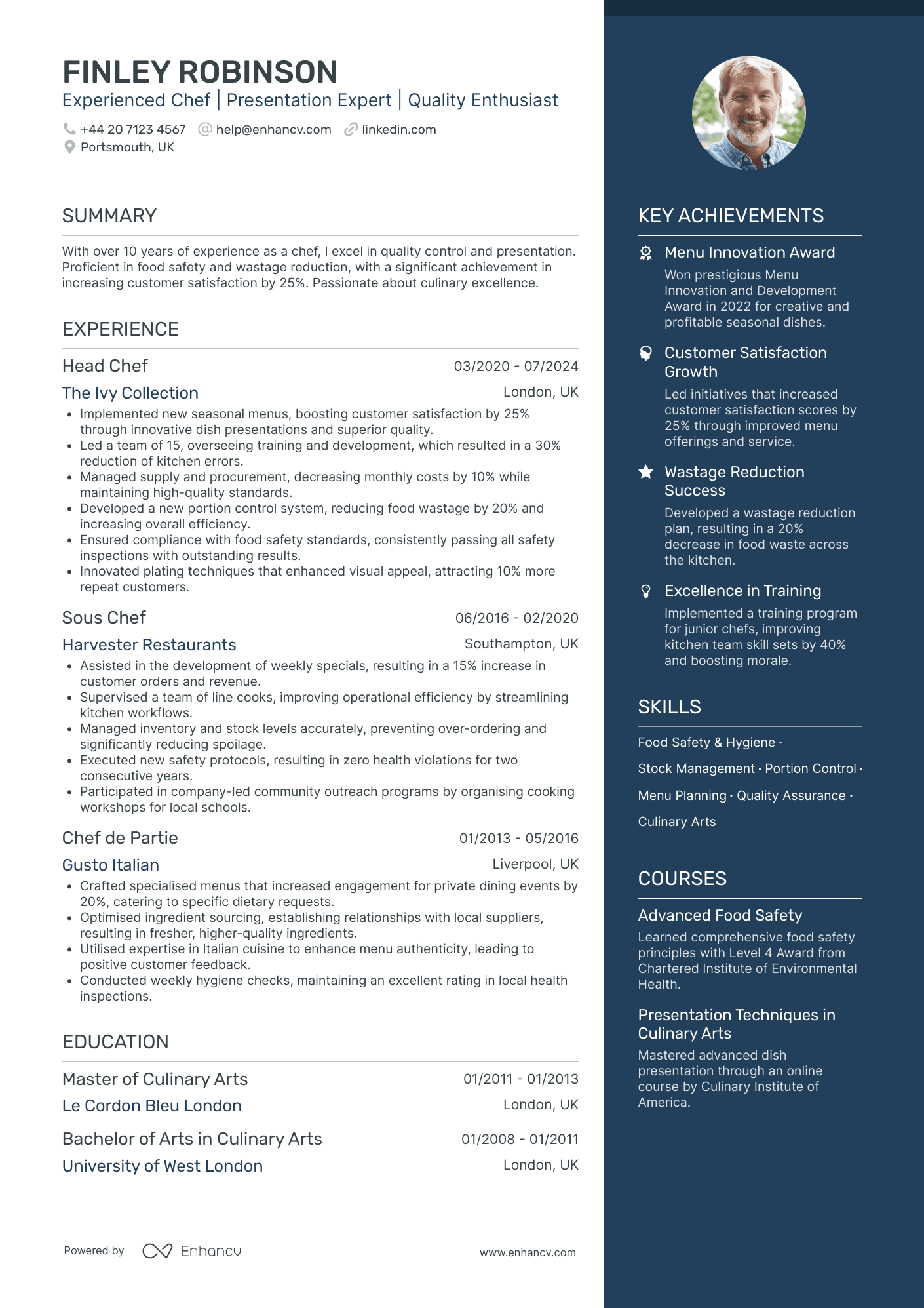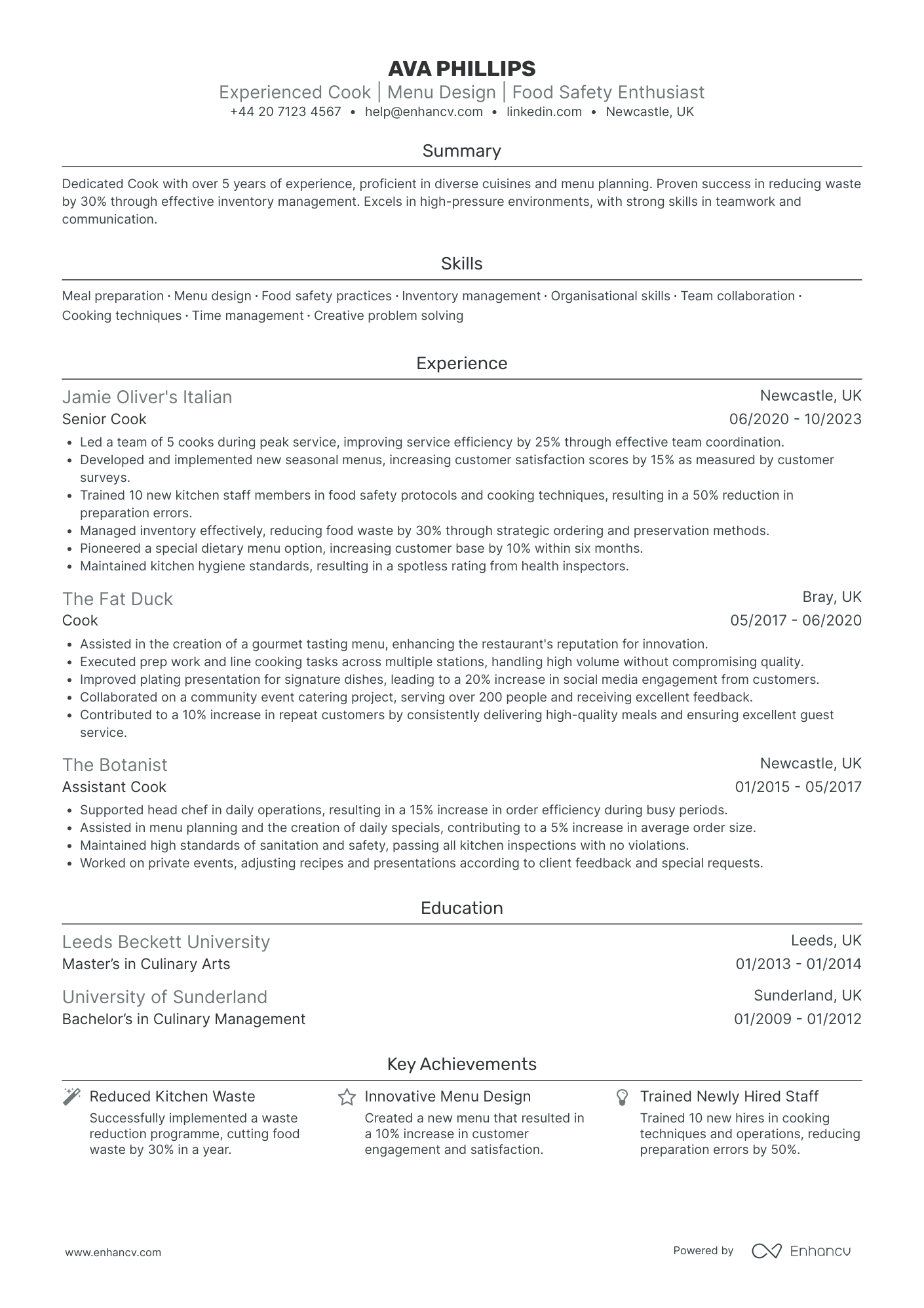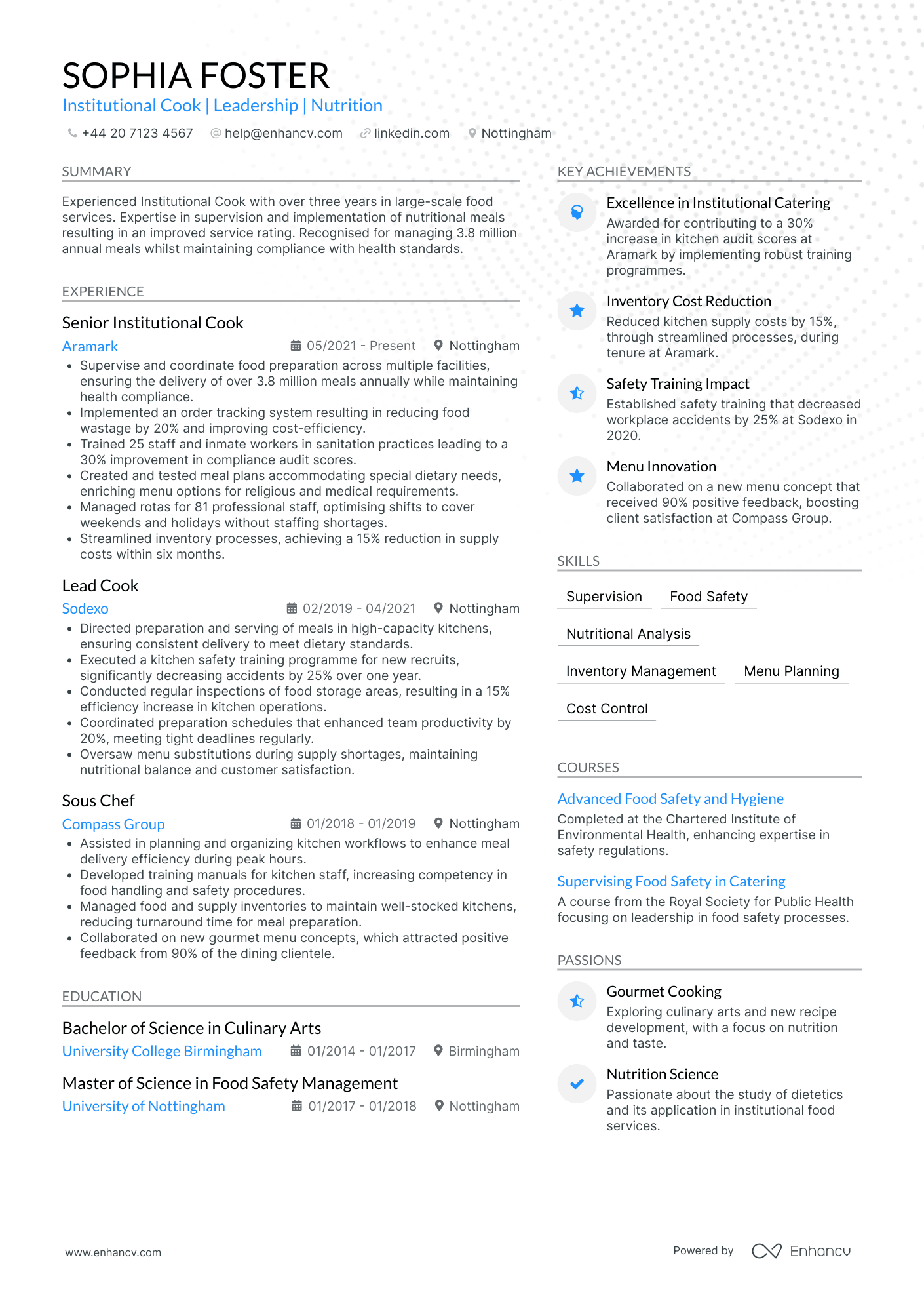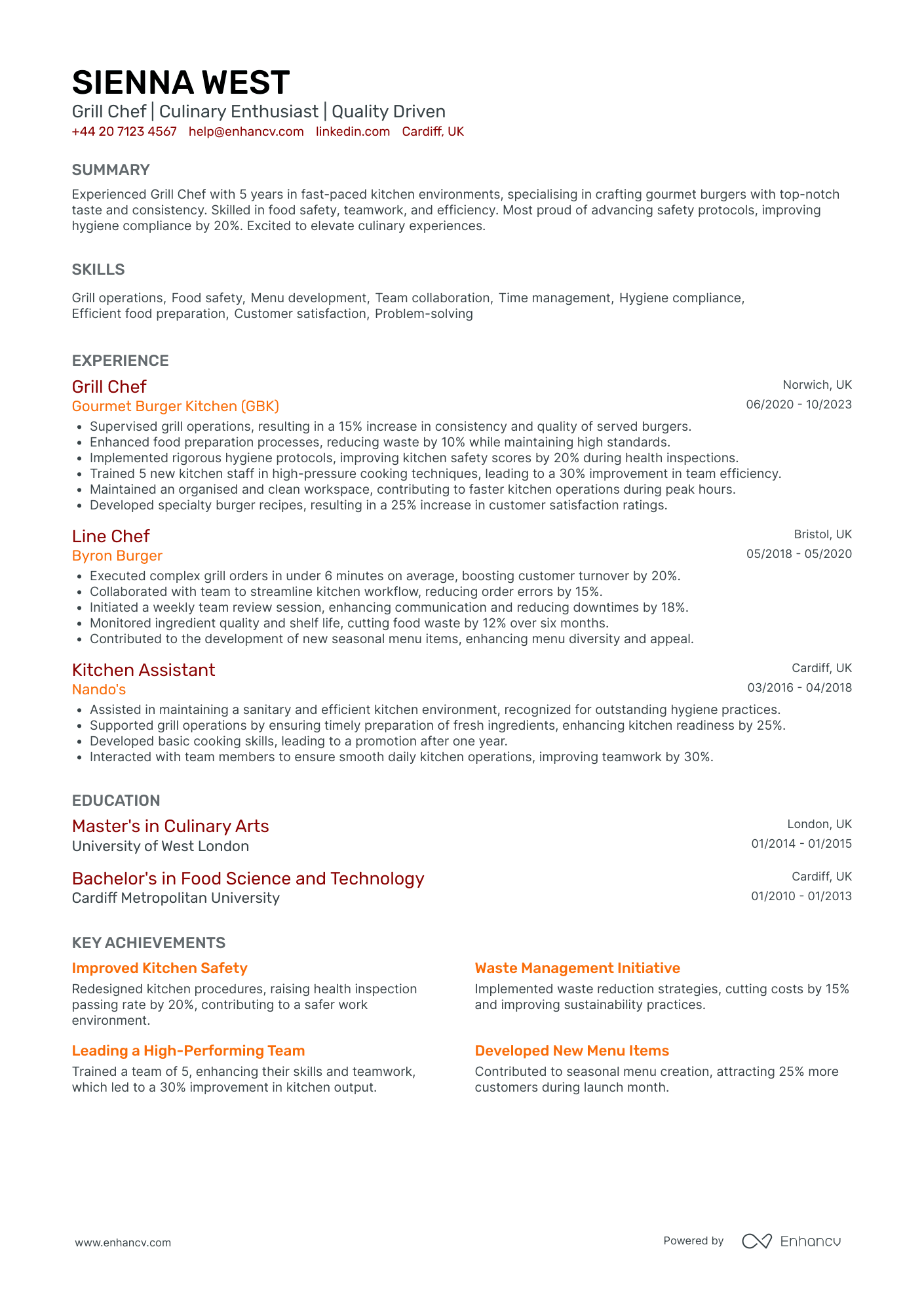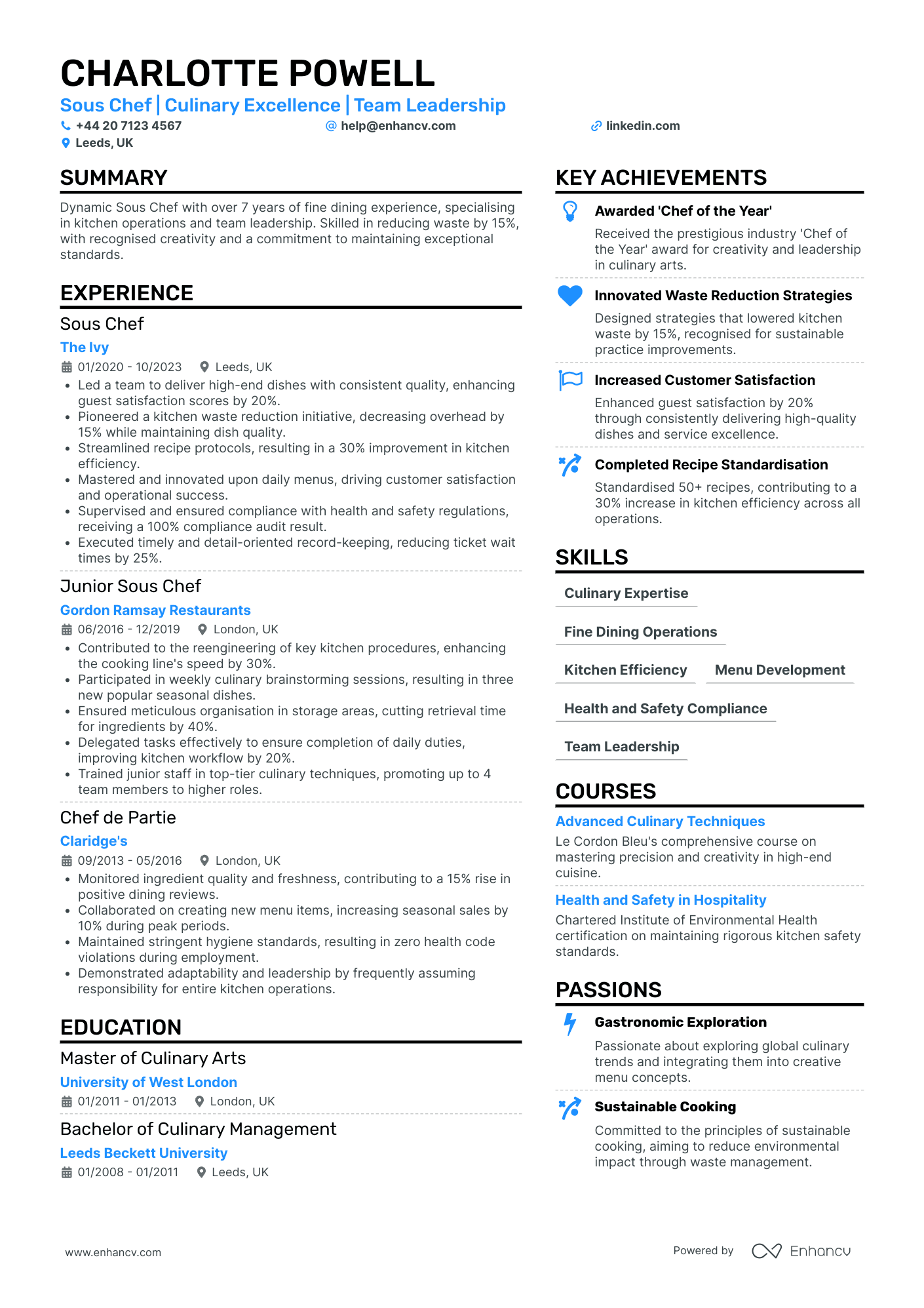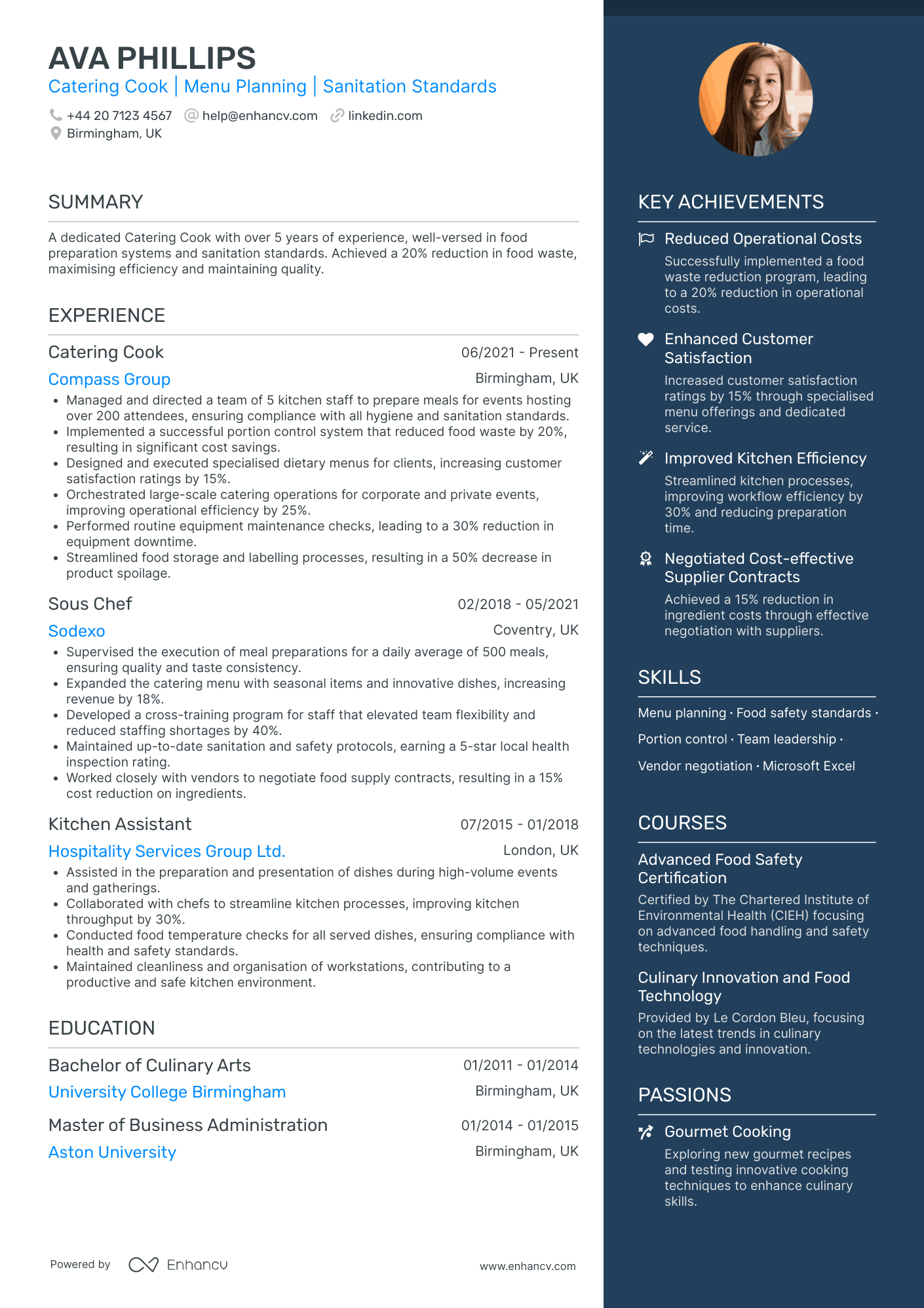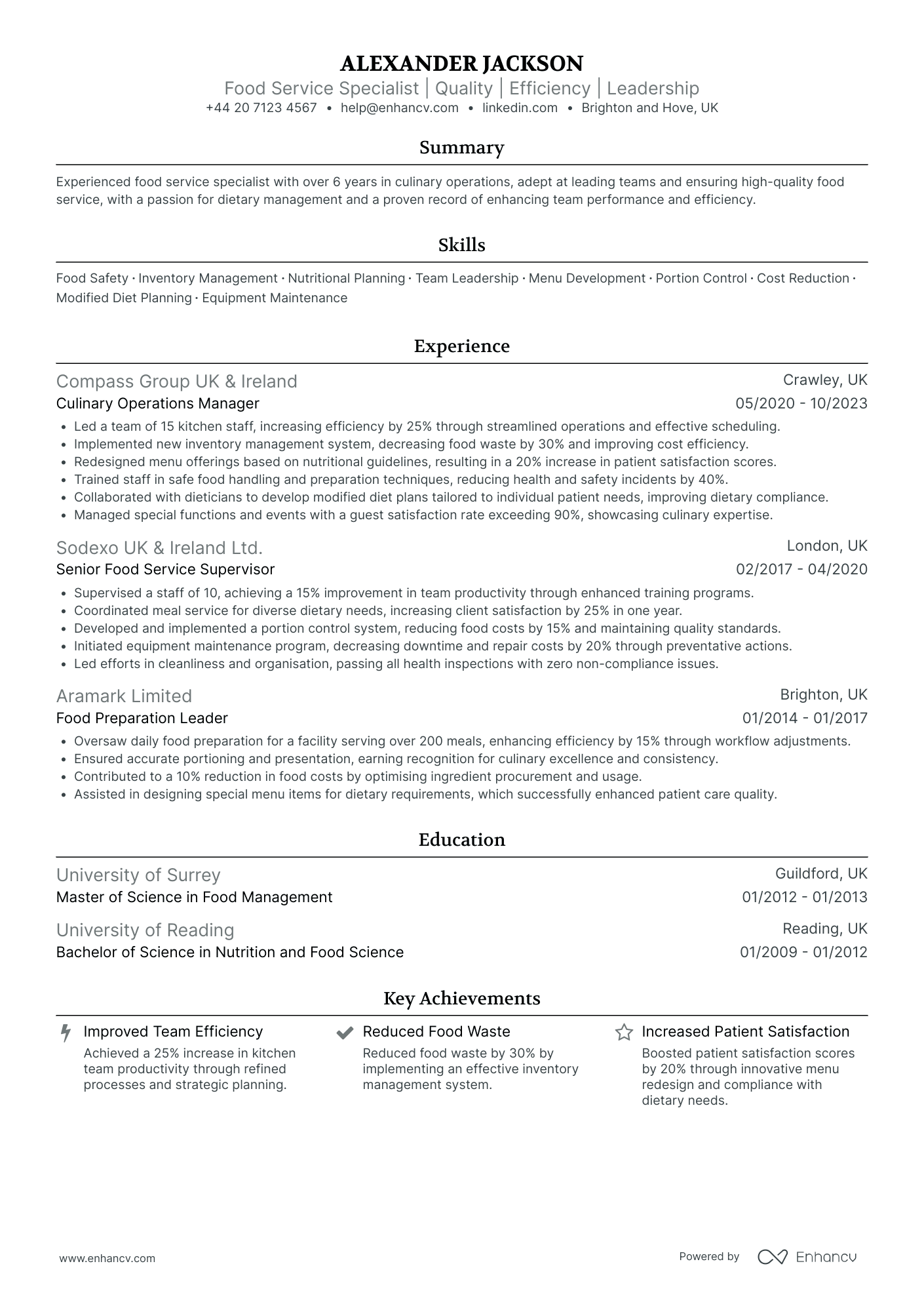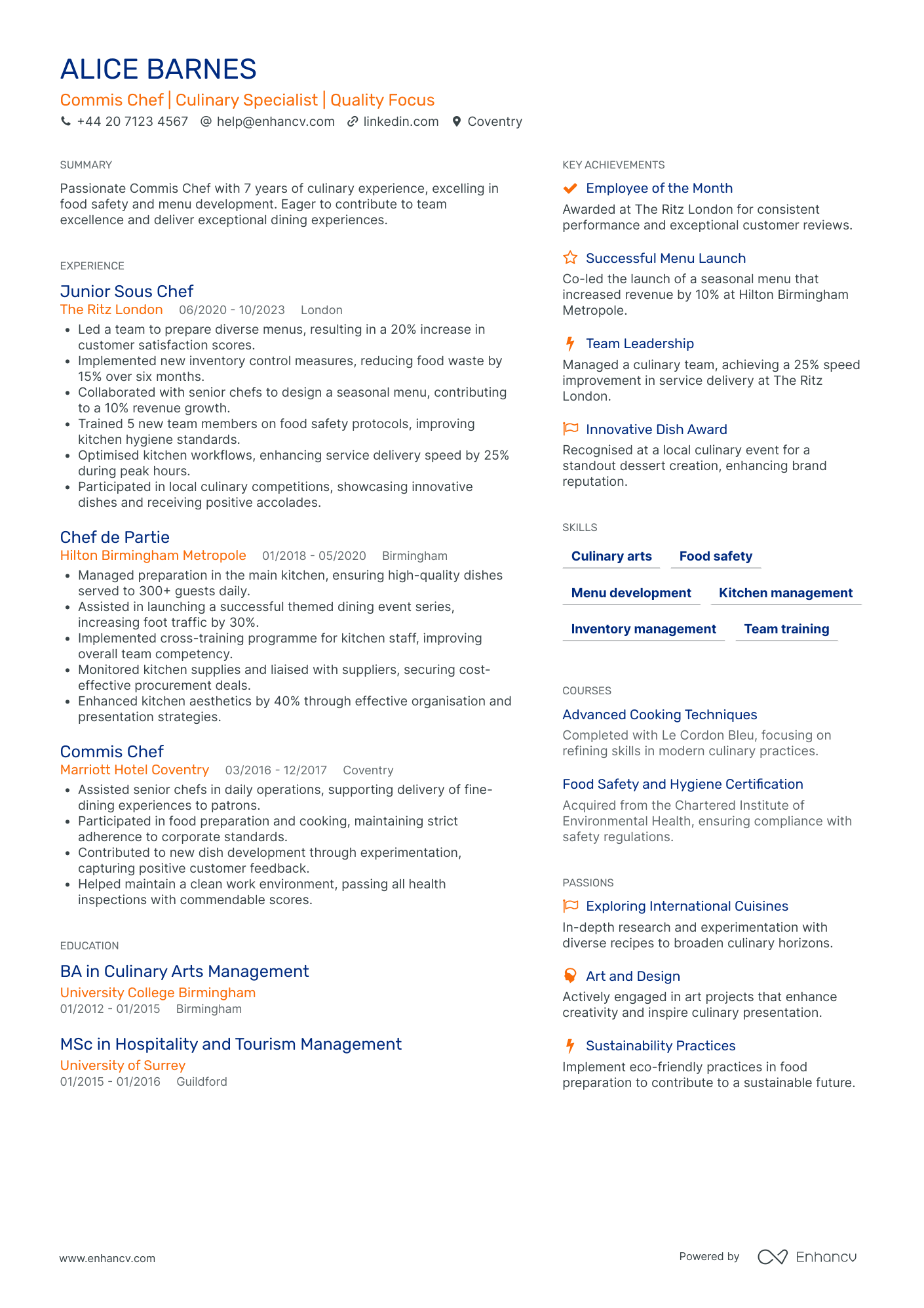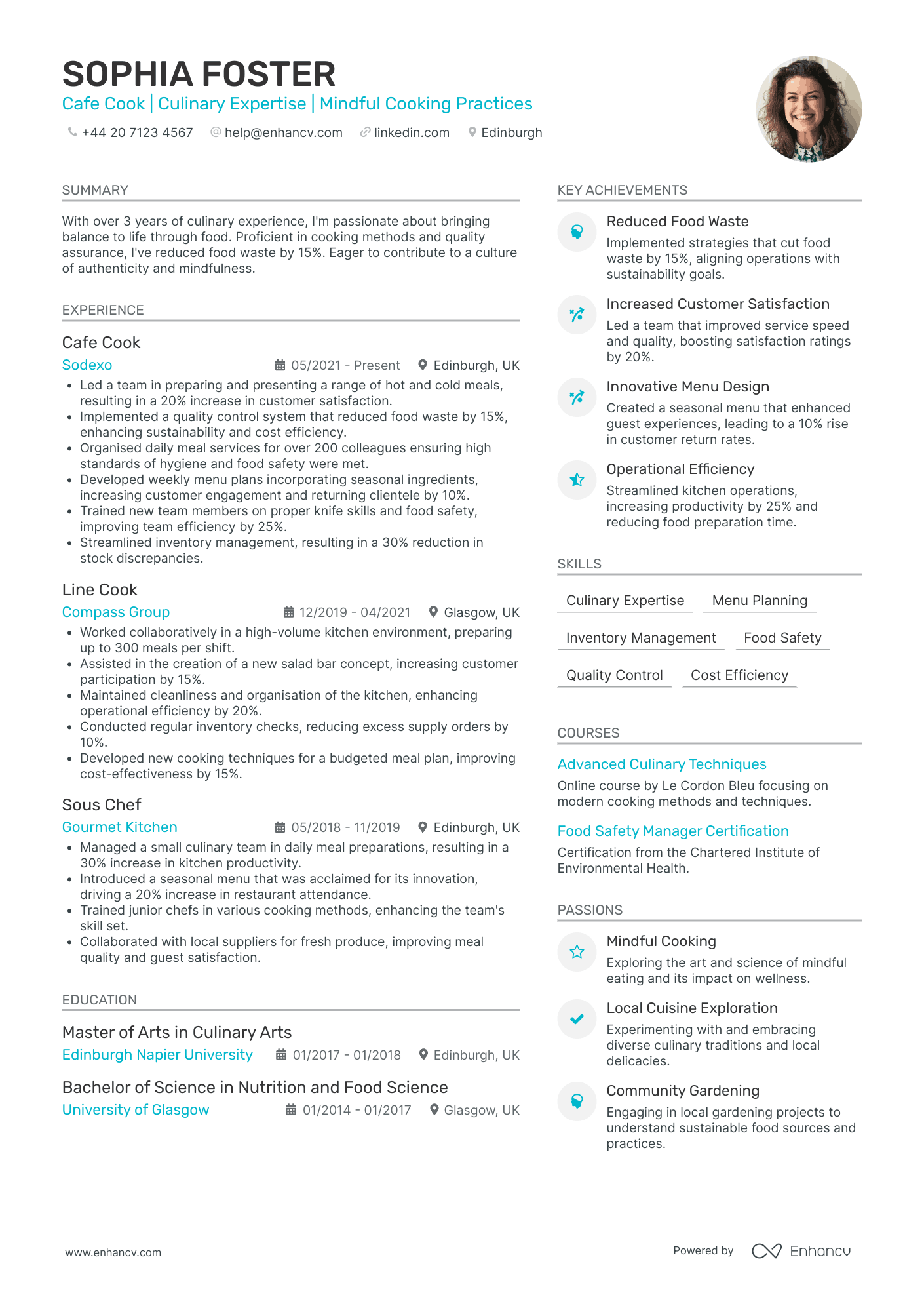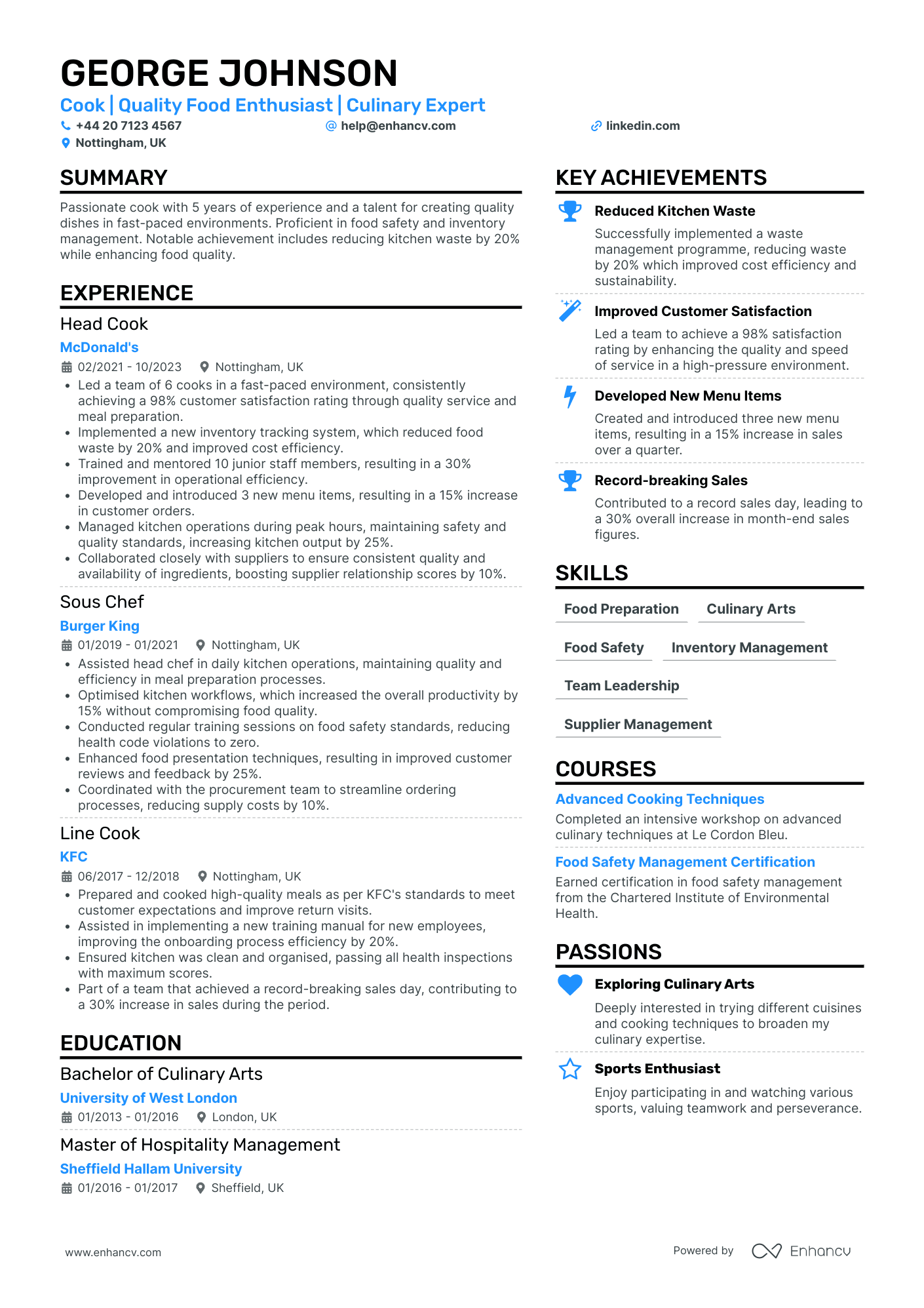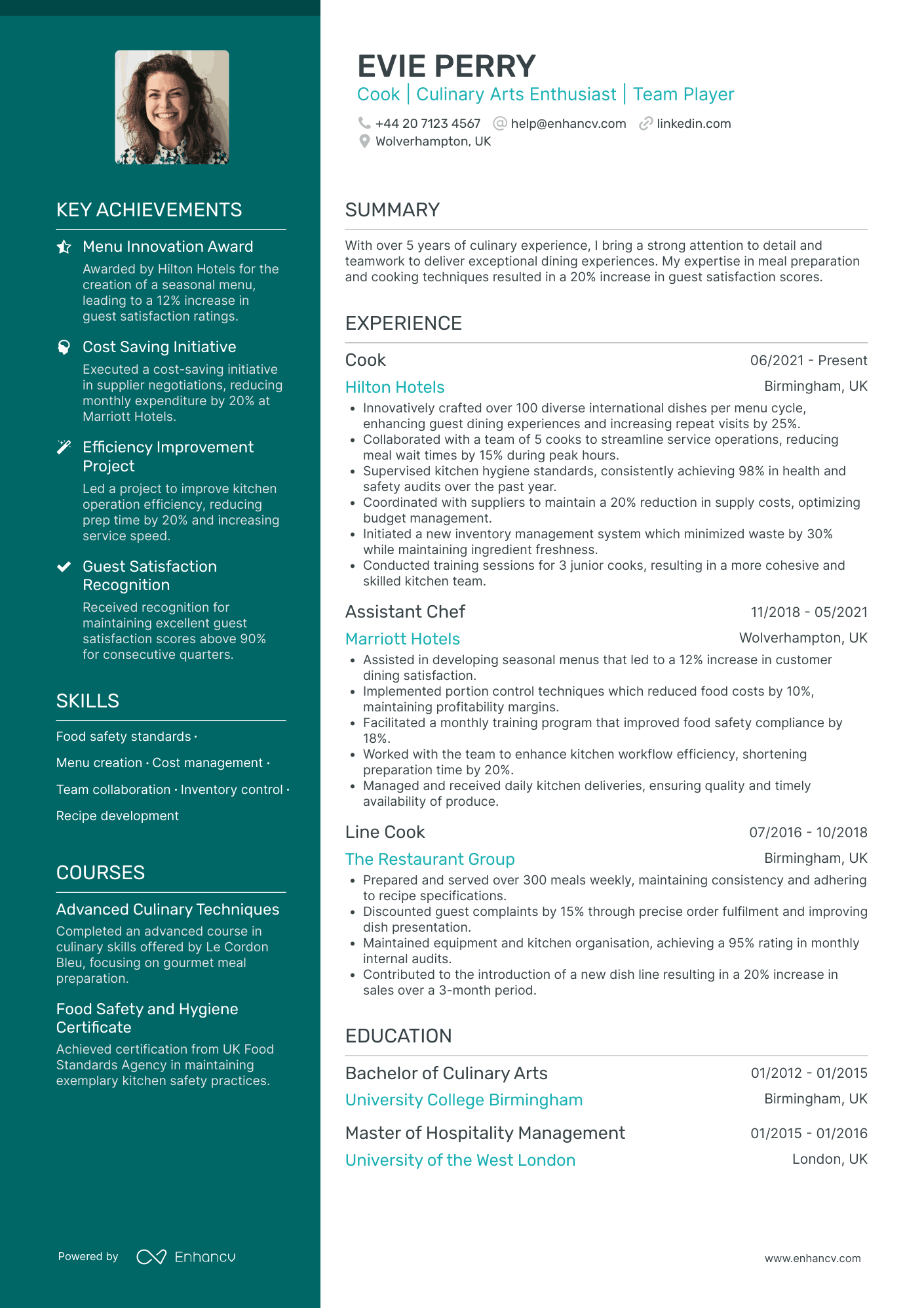Crafting a compelling CV as a cook can prove challenging when trying to convey the uniqueness of your culinary style and experiences. Our guide offers targeted advice to distil your kitchen prowess into an engaging narrative that captures the attention of potential employers.
- Applying the simplest CV design, so that recruiters can easily understand your expertise, skills, and professional background;
- Ensuring you stand out with your header, summary or objective statement, and a designated skills section;
- Creating your CV experience section - no matter how much expertise you have;
- Using real life professional CV examples to enhance the structure and outline of your profile.
If you still have no muse to write your professional CV, find some more industry-leading examples.
Resume examples for cook
By Experience
Apprentice Cook
- Structured and Concise Presentation - Chloe Bell's CV is well-organized, beginning with a clear header that quickly conveys key personal information, followed by sections for summary, experience, education, and skills. The concise language and bullet-point format make it easy to navigate and extract relevant information efficiently, ideal for fast-paced review settings.
- Demonstrates Career Progression - The CV clearly illustrates Chloe’s career growth in the culinary industry, moving from a Commis Chef at Hilton Hotels to a Sous Chef at Marriott Hotels. This progression indicates strong professional development, skill enhancement, and capability to handle increased responsibilities over time.
- Emphasis on Cross-training and Adaptability - The CV highlights Chloe's initiative in cross-training programs, showcasing her adaptability and commitment to enhancing her skills and those of her team. This indicates a proactive approach to learning and a focus on creating versatile, multi-skilled teams within the culinary field.
Lead Cook
- Structured Career Progression - Chloe Bell's career trajectory is well-mapped, showing a clear progression from Culinary Assistant to Catering Supervisor. This upward movement within the hospitality industry reflects her growing expertise and increased responsibilities over time, such as managing larger teams and more complex operations.
- Focus on Leadership and Team Development - Chloe demonstrates a strong emphasis on team leadership and development. By managing diverse teams and providing staff training, she has successfully improved operational efficiency and compliance rates, which highlights her capability to foster a productive and compliant work environment.
- Effective Achievement Narratives - The CV effectively communicates Chloe's achievements not just in numerical terms but in business impact, like how her initiatives led to significant improvements in customer satisfaction and event bookings. This focus on result-driven success stories underscores her value to potential employers in the hospitality industry.
Executive Cook
- Effective Content Presentation - The CV's structure is highly organized and concise, allowing for easy navigation through sections. Key information such as experience, education, and achievements are clearly segmented, enabling quick identification of the candidate's qualifications and accomplishments. This clarity ensures the reader's engagement from start to finish.
- Progressive Career Trajectory - Eva Fisher's career path showcases significant growth and upward mobility within the culinary industry. Starting as a Sous Chef and moving up to the Executive Chef position demonstrates her ability to assume greater responsibilities and adapt to various roles within high-pressure environments, particularly in senior living communities.
- Demonstrated Achievement Impact - The CV highlights achievements with quantifiable results, such as the 20% increase in client satisfaction and a 28% increase in client retention due to a catering program. These achievements underscore the candidate's capability to generate significant business outcomes and enhance service delivery within her domain.
By Role
Line Cook
- Clear Career Trajectory - Daniel's CV highlights a well-defined career path with progressive responsibilities. Starting as an Assistant Cook, he advanced to a Cook, and eventually to a Line Cook with leadership duties in renowned establishments, showing a steady upward trend in responsibility and expertise.
- Strong Emphasis on Cross-Functional Experience - The CV showcases Daniel's ability to work collaboratively in both kitchen and front-of-house settings, depicting strong cross-functional skills. His coordination with front-of-house staff to enhance customer experience underlines his adaptability and effective communication abilities.
- Impactful Achievements with Business Relevance - Daniel’s achievements aren't just numeric; they tie directly to business improvements. For instance, reducing kitchen wait times by 15% directly correlates with improved customer satisfaction, showcasing his contributions to operational excellence and customer service enhancements.
Head Cook
- Structured and Concise Presentation - Elsie's CV is well-organized, providing clarity by dividing sections into clearly marked categories like experience, education, and achievements. Each section is concise yet informative, effectively communicating her skills and career highlights without overwhelming the reader with excessive details.
- Progressive Career Trajectory - The CV outlines a consistent progression of roles from Sous Chef to Catering Operations Manager, illustrating her career growth and increasing responsibility within the industry. This trajectory showcases Elsie's ability to advance through practical experience and skill enhancement, underpinning her leadership capacities.
- Impactful Achievements with Business Relevance - Elsie's accomplishments are presented with quantifiable results, such as reducing food costs by £20,000 annually and leading a kitchen refurbishment that improved efficiency by 25%. These metrics emphasize her effectiveness in achieving business goals, boosting operational efficiency, and contributing to customer satisfaction.
Pastry Cook
- Clear and Structured Presentation - The CV impressively organizes complex information into clear sections, featuring concise bullet points that effectively showcase the candidate's skills and accomplishments. This makes the content easy to follow, ensuring that key achievements and career milestones are quickly grasped by the reader.
- Consistent Career Growth with Industry Prestige - James Lewis's career trajectory reflects a steady climb through prestigious institutions, from Le Manoir aux Quat' Saisons to Gordon Ramsay Restaurant, each offering Michelin-star credibility. Each role demonstrates natural progression in responsibility and influence, highlighting a dedication to excellence and professional development.
- Innovative Culinary Expertise and Sustainability - The CV excels in detailing unique industry-specific elements such as innovative dessert techniques and notable sustainability initiatives. The candidate’s contributions to crafting award-winning desserts and reducing waste underscore his command of technical skills and commitment to environmentally-friendly practices in a competitive, high-stakes environment.
Grill Cook
- Structured and Concise Presentation - The CV is well-organized with clearly defined sections such as experience, education, skills, and achievements, which allows for easy navigation and understanding. The use of bullet points in the experience section ensures clarity and conciseness, highlighting key accomplishments efficiently, making it accessible for a quick review by potential employers.
- Prominent Career Growth - Chloe Bell's career trajectory reflects a steady upward progression in the culinary field, demonstrating her evolution from an Assistant Cook to a Grill Chef at prominent establishments. This linear growth showcases her dedication to culinary arts and her ability to take on increasingly responsible roles, underscoring her commitment to career advancement within the industry.
- Emphasis on Food Safety and Quality Control - The CV distinctly underscores Bell's expertise in food safety and quality control, aspects crucial to the culinary industry. Her educational background, courses, and notable achievements in maintaining health inspection success and recipe optimization are compelling evidence of her technical depth and specialization in these critical areas.
Fry Cook
- Structured career progression - The CV outlines a clear career trajectory, showing progression from Kitchen Assistant to Line Cook, and Assistant Chef. This demonstrates growth within the culinary industry and an ability to take on increased responsibilities, reflecting strong ambition and commitment.
- Significant achievements with business impact - Beyond listing roles and responsibilities, the CV highlights key achievements such as reducing food waste by 15%, boosting customer engagement by designing a new menu, and enhancing team productivity. These accomplishments indicate a focus on tangible business outcomes and improving operational and financial performance.
- Specialized technical and soft skills combined - The CV showcases a well-rounded skill set that includes both technical competencies like advanced food safety and kitchen equipment operation, and soft skills such as teamwork, communication, and customer service. This balance suggests the potential for Sophia Brooks to excel in dynamically complex environments like the culinary sector.
Prep Cook
- Strong Career Progression - Daniel’s CV showcases a clear trajectory of growth in the culinary field, with a steady advancement from Commis Chef to Sous Chef. This progression highlights his ability to take on increased responsibility and manage kitchen operations effectively over time.
- Impressive Achievements and Impact - The CV is rich with quantifiable achievements, such as a 15% increase in kitchen productivity and a 12% reduction in food wastage. These accomplishments demonstrate Daniel’s capability to drive substantial business improvements through his culinary and management skills.
- Adaptability and Cross-Cultural Experience - Daniel's experience in different UK cities, including Newcastle, Edinburgh, and Manchester, indicates a strong adaptability to various culinary environments and demands. This flexibility is crucial in the dynamic nature of the food service industry, where regional trends and customer preferences can widely vary.
Banquet Cook
- Structure and Clarity - The CV is structured with clear headers and sections, making it easy for potential employers to navigate through important information. Each segment such as experience, education, skills, and achievements is well-organized, enhancing readability and ensuring crucial details are not overlooked.
- Progressive Career Growth - Throughout the CV, Finley Robinson demonstrates a steady career progression, advancing from a Chef de Partie to a Head Chef. This trajectory illustrates not only a buildup of experience but also enhanced responsibilities and influence, such as leading larger teams and implementing kitchen-wide initiatives.
- Innovative Contributions to Culinary Arts - Unique elements like developing a portion control system and creating innovative plating techniques highlight the candidate's technical depth and contribution to operational improvements. These innovations reflect Finley's capacity to integrate creativity with efficiency, directly impacting customer satisfaction and the establishment’s reputation.
Short Order Cook
- Concise and Structured Presentation - The CV is meticulously organized, presenting detailed information in a clear and concise manner. Each section is well-defined, allowing for easy navigation and quick understanding of the candidate's qualifications and achievements. The use of bullet points in the experience section effectively highlights key contributions and outcomes.
- Impressive Career Progression - Ava Phillips demonstrates a steady career trajectory with notable advancements in the culinary industry. Moving from an Assistant Cook to a Senior Cook, Ava's growth is marked by increasing responsibilities, such as team leadership and menu development, showcasing her enhanced expertise and commitment to professional development.
- Emphasis on Sustainability and Innovation - The CV uniquely underscores industry-specific elements such as sustainable cooking practices and culinary innovation. Initiatives like waste reduction programs and new menu designs not only highlight Ava's technical depth but also her dedication to evolving culinary trends and her proactive approach to improving business outcomes.
Institutional Cook
- Structured and Concise Presentation - The CV is meticulously formatted, clearly dividing information into intuitive sections. This clarity ensures easy navigation, making it seamless for potential employers to identify key areas such as experience, skills, and education. The bullet points are concise yet informative, effectively summarizing the candidate's extensive expertise without overwhelming the reader.
- Progressive Career Advancement - Sophia Foster's career trajectory is a testament to consistent growth and development, moving from a Sous Chef to Senior Institutional Cook roles within renowned organizations like Aramark and Sodexo. This progression illustrates not only her expertise in culinary management but also her ability to take on increasing levels of responsibility, demonstrating leadership in food service operations.
- Impactful Achievements with Business Relevance - The CV highlights accomplishments that have significantly impacted business operations, such as a reduction in food wastage by 20% through an order tracking system, and a 15% cost reduction in supply expenses. These achievements showcase her strategic insights into operational efficiency and cost control, valuable assets in institutional catering.
Gourmet Cook
- Clear and structured presentation - The CV is well-organized, with sections dedicated to experience, education, skills, courses, achievements, languages, and passions. This structured approach allows potential employers to quickly grasp the candidate's qualifications and strengths, ensuring that key information is easily accessible.
- Strong career growth trajectory - Sienna West's career path shows significant progression, starting as a Kitchen Assistant and advancing to a Grill Chef within a few years. Her transition from Nando's to Gourmet Burger Kitchen is marked by increased responsibility, indicating her growth in expertise and leadership in the culinary field.
- High-impact industry achievements - The CV highlights Sienna's notable achievements, such as improving kitchen safety protocols, leading to a 20% raise in inspection scores, and developing specialty burger recipes that increased customer satisfaction by 25%. These achievements underscore her ability to bring about substantial improvements and add value to her workplace.
Saute Cook
- Strategic Career Growth in Culinary Arts - Charlotte's career trajectory demonstrates a clear and strategic progression from Chef de Partie to Sous Chef. With each role at esteemed culinary establishments like Claridge's and Gordon Ramsay Restaurants, she has advanced by developing critical skills in kitchen operations, team management, and waste reduction strategies, preparing her thoroughly for a leadership position.
- Quantifiable Contributions Enhancing Business Performance - The CV effectively outlines Charlotte's ability to drive significant business outcomes through her culinary expertise. Achievements such as reducing kitchen waste by 15% and increasing customer satisfaction demonstrate her impact on operational efficiency and the overall diner's experience at top-tier restaurants like The Ivy and Gordon Ramsay Restaurants.
- Leadership and Team Development Skills - Charlotte's experience highlights her strength in leadership, as seen in her role leading a team at The Ivy to improve guest satisfaction by 20% and training junior staff at Gordon Ramsay Restaurants, resulting in promotions. Her ability to mentor future chefs reflects her dedication to fostering a positive and growth-oriented work environment.
Catering Cook
- Clear and Structured Content Presentation - The CV is well-organized with each section clearly defined, making it easy to navigate. The use of bullet points under each position helps in succinctly presenting key responsibilities and achievements, ensuring clarity and focus on essential information.
- Progressive Career Trajectory - Ava’s career exhibits a strong upward trajectory, moving from a Kitchen Assistant to a Sous Chef and then to a Catering Cook. Each role reflects an increase in responsibilities and achievements, indicating professional growth and adaptability within the culinary industry.
- Achievements with Tangible Business Impact - The CV highlights significant achievements with a focus on business outcomes, such as reducing food waste by 20% and increasing customer satisfaction by 15%. These accomplishments demonstrate Ava's ability to not only improve kitchen operations but also contribute positively to the company’s bottom line.
Hospital Cook
- Impressive Career Progression - The CV effectively showcases a clear growth trajectory, demonstrating Alexander's advancement from a Food Preparation Leader to a Culinary Operations Manager over a span of nearly a decade. This progression highlights a consistent dedication to career development within the food service industry, indicating strong potential for leadership roles.
- Focus on Efficiency and Innovation - Throughout the CV, there's a notable emphasis on implementing innovative strategies to improve efficiency, such as reducing food waste by 30% and increasing team productivity by 25%. These achievements illustrate not only a capability for strategic thinking but also a commitment to operational excellence and sustainable practices in the culinary domain.
- Leadership and Training Impact - Alexander’s CV underscores strong leadership abilities, detailing how he led teams to success through enhanced training programs that improved productivity and reduced health incidents significantly. This focus on fostering a supportive and proactive team environment underscores his potential to inspire and guide teams towards achieving performance targets.
Restaurant Cook
- Exemplary Content Organization - The CV is organized in a highly readable format, incorporating clear headings and bullet-point lists that allow hiring managers to quickly assess the candidate's qualifications and experiences. The use of concise language ensures that each section is informative without overwhelming the reader with information.
- Dynamic Career Progression - The candidate showcases impressive advancement throughout their career, with clear evidence of promotions in their roles at various industry-leading firms. This trajectory indicates a strong capacity for growth and adaptability, traits valuable in fast-paced professional environments.
- Industry-Specific Technical Expertise - The CV includes detailed descriptions of specialized tools and methodologies relevant to the digital marketing and SEO fields, such as using advanced analytics platforms and content management systems. These insights reveal the candidate's commitment to leveraging the latest technologies for strategic advantage.
Cafeteria Cook
- Structurally coherent and concise - Sophia's CV is presented with a clear structure that categorically segments her professional experience, education, skills, and other relevant sections. Each section is concise, focusing on key achievements and responsibilities that directly demonstrate her capabilities, making the information easily digestible.
- Steady career progression in culinary roles - The document showcases a logical career trajectory within the culinary industry, starting as a Sous Chef, moving to Line Cook, and advancing to a Cafe Cook. Each step reflects a growth in responsibility and impact, emphasizing her dedication and achievement in her field.
- Integration of mindful cooking principles - A distinctive element of Sophia's profile is her focus on mindful cooking practices, a unique angle that aligns with modern culinary trends. This focus, along with her experience in reducing food waste and promoting sustainability, addresses both consumer interests and business efficiencies.
Fast Food Cook
- Logical Structure with Distinct Sections - The CV is well-organized with clearly defined sections such as Professional Experience, Skills, Education, and Certifications, making it easy for hiring managers to quickly locate pertinent information. Each section is marked by clear headings and consistent formatting, contributing to the overall readability and visual appeal of the document.
- Dynamic Career Trajectory with Industry Transitions - The CV showcases a dynamic career path that includes strategic roles across various industries, indicating a flexible and ambitious professional. The progression from entry-level roles to leadership positions demonstrates a clear pattern of growth and an ability to adapt to new challenges and environments, underscoring the candidate's resilience and commitment to personal development.
- Emphasis on Advanced Data Analytics Tools - The CV highlights specific expertise in industry-standard analytical tools like Tableau, Power BI, and SQL, which are critical for driving data-driven decision-making in today's market. This technical depth underscores the candidate’s ability to provide valuable insights and data-supported strategies, positioning them as a key asset for roles that leverage big data and predictive analytics to optimize business outcomes.
Hotel Cook
- Content Presentation and Clarity - The CV is structured in a coherent manner, presenting information in a concise and clear format. Sections such as experience, education, skills, and achievements are well-delineated, allowing for easy navigation and comprehension. The use of bullet points under job descriptions ensures that the reader can quickly grasp key responsibilities and accomplishments.
- Career Trajectory and Growth - Evie Perry's career path showcases a clear upward trajectory, marked by promotions from Line Cook to Assistant Chef and ultimately to Cook at prestigious hotels like Hilton. This progression reflects a growing capacity for responsibility and leadership within the culinary industry, underscored by the candidate's ability to innovate and enhance guest satisfaction.
- Achievements and Impact - The CV highlights significant achievements with detailed insights into their business relevance. For instance, Evie increased guest satisfaction scores by 20% through her expertise in meal preparation and cooking techniques, demonstrating her direct impact on customer experience and loyalty. Her achievements are quantitatively backed, showcasing her ability to deliver substantial and positive outcomes within her roles.
Structuring your cook CV layout: four factors to keep in mind
There are plenty of best practices out there for your CV layout and design. At the end of the day, a clear format and concise CV message should be your top priority. Use your CV design to enhance separate sections, bringing them to the forefront of recruiters' attention. At the same time, you can write content that:
- Follows the reverse chronological order in the experience section by first listing your most recent jobs;
- Incorporates your contact information in the header, but do skip out on the CV photo for roles in the UK;
- Is spotlighted in the most important sections of your CV, e.g. the summary or objective, experience, education, etc. to show just how you meet the job requirements;
- Is no longer than two-pages. Often, the one-page format can be optimal for your cook CV.
Before submitting your CV, you may wonder whether to export it in Doc or PDF. With the PDF format, your information and layout stay intact. This is quite useful when your CV is assessed by the Applicant Tracker System (or the ATS) . The ATS is a software that scans your profile for all relevant information and can easily understand latest study on the ATS , which looks at your CV columns, design, and so much more.
PRO TIP
For certain fields, consider including infographics or visual elements to represent skills or achievements, but ensure they are simple, professional, and enhance rather than clutter the information.
The top sections on a cook CV
- Professional Summary details your passion and expertise.
- Employment History showcases your experience in kitchens.
- Culinary Skills highlight the techniques you've mastered.
- Education & Training show your formal culinary qualifications.
- Food Safety Certification proves your knowledge in hygiene.
What recruiters value on your CV:
- Highlight your culinary skills and techniques by detailing specific dishes or cuisines you are proficient in, which showcases your expertise and area of specialisation in the kitchen.
- Emphasize any experience with menu planning and development, as this demonstrates creativity and an understanding of pairing flavours and designing meals that appeal to various palates.
- Include any formal culinary education or apprenticeships, to validate your technical knowledge and commitment to the craft of cooking.
- Mention experience with inventory management and cost control, which are crucial for a cook's role in maintaining kitchen efficiency and profitability.
- Note any accolades or recognition you have received, such as awards or positive reviews, to provide evidence of your talent and successful track record in the culinary field.
Recommended reads:
What information should you include in your cook CV header?
The CV header is potentially the section that recruiters would refer to the most, as it should include your:
- Contact details - your professional (non-work) email address and phone number;
- Professional photograph - if you're applying hinting at the value you bring as a professional.
Many professionals often struggle with writing their cook CV headline. That's why in the next section of this guide, we've curated examples of how you can optimise this space to pass any form of assessment.
Examples of good CV headlines for cook:
- Sous Chef | Innovative Mediterranean Cuisine | Health & Nutrition Focused | Culinary Arts Degree | 5+ Years Experience
- Pastry Chef de Partie | French Patisserie Specialist | Chocolate Artistry | Level 3 Patisserie Diploma | 3 Years Expertise
- Executive Chef | Fine Dining & Menu Development | Leadership in Multi-Cultural Teams | 10+ Years Culinary Journey
- Commis Chef | Fast-Paced Brasserie | Food Safety Certified | Passion for Local Produce | 2 Years Professional Cooking
- Head Chef | Gastropub Excellence | Farm-to-Table Advocate | Menu Innovation | Advanced Food Hygiene Certificate | 7 Years
- Junior Sous Chef | Asian Fusion Expert | Creative Recipe Design | Culinary Management Graduate | Rising Star with 4 Years’ Experience
Catching recruiters' attention with your cook CV summary or objective
Located closer to the top of your CV, both the summary and objective are no more than five sentences long and serve as an introduction to your experience. What is more, you could use either to entice recruiters to read on. Select the:
- Summary, if you happen to have plenty of relevant experience. Feature your most impressive accomplishments and up to three skills that are relevant to the job you're applying for;
- Objective, if you're just starting your career off. Provide your career goals and answer how you see the role you are applying for will match your professional growth.
Judging which one you need to add to your cook CV may at times seem difficult. That’s why you need to check out how professionals, with similar to your experience, have written their summary or objective, in the examples below:
CV summaries for a cook job:
- With over a decade of experience as a Head Chef in bustling London bistros, I possess a robust repertoire of Mediterranean and French cuisines, coupled with a track record of reducing food costs by 30% through strategic menu development and ingredient sourcing.
- Dedicated Pastry Chef with 8 years of creating exquisite French pastries in the vibrant patisseries of Paris, awarded “Best Chocolate Confection” at the 2021 Paris Baking Exhibition, seeking to bring international expertise to a new culinary environment.
- A former Sous-Chef with a passion for Japanese cuisine, transitioning to a career as a Sushi Chef, currently mastering the art of sushi preparation with prominent Tokyo mentors to bring authentic flavours and innovative presentations to a dynamic team.
- An experienced Farm Manager with a newfound love for culinary arts, actively pursuing a Diploma in Culinary Management, eager to apply sustainable farming practices and knowledge of fresh, organic produce to creative and health-conscious menu planning.
- As a newcomer to professional kitchens, I aim to leverage a meticulous approach and a rapid learning curve developed during a Bachelor's degree in Hospitality Management to excel in cooking and create memorable dining experiences for guests.
- Aiming to merge an enthusiastic approach and admiration for global cuisines with a recent Culinary Arts certification, I’m seeking to ignite my cooking career by contributing freshly acquired skills and embracing the mentorship of a seasoned kitchen brigade.
The best formula for your cook CV experience section
The CV experience section is the space where many candidates go wrong by merely listing their work history and duties. Don't do that. Instead, use the job description to better understand what matters most for the role and integrate these keywords across your CV. Thus, you should focus on:
- showcasing your accomplishments to hint that you're results-oriented;
- highlighting your skill set by integrating job keywords, technologies, and transferrable skills in your experience bullets;
- listing your roles in reverse chronological order, starting with the latest and most senior, to hint at how you have grown your career;
- featuring metrics, in the form of percentage, numbers, etc. to make your success more tangible.
When writing each experience bullet, start with a strong, actionable verb, then follow it up with a skill, accomplishment, or metric. Use these professional examples to perfect your CV experience section:
Best practices for your CV's work experience section
- Demonstrated proficiency in high-volume environments by efficiently preparing up to 150 meals per shift whilst maintaining high-quality standards.
- Specialised in Mediterranean cuisine, successfully incorporating authentic ingredients to create traditional dishes for an exclusive clientele.
- Implemented inventory control procedures that reduced food waste by 20%, demonstrating a strong understanding of cost-effective kitchen management.
- Collaborated with a team of 10 chefs, ensuring seamless kitchen operations during peak hours and maintaining exceptional levels of customer satisfaction.
- Developed and executed a rotating menu that increased repeat customer visits by 30%, showcasing culinary creativity and responsiveness to customer preferences.
- Maintained an impeccably clean and sanitary kitchen workspace in compliance with food safety regulations, scoring 98% in health inspections consistently.
- Pioneered a farm-to-table programme that supported local producers and resulted in fresher ingredients for the restaurant's seasonal menus.
- Mentored four junior cooks through a rigorous apprenticeship programme, enhancing overall team skills and contributing to the restaurant's reputation for excellence.
- Regularly received commendations for attention to detail and artful presentation, evidencing the ability to not only cook but also beautifully plate dishes.
- Consistently maintained high levels of customer satisfaction, contributing to a 30% increase in repeat diners at a renowned gastropub.
- Streamlined the food preparation process by introducing a more efficient mise en place, thereby reducing food waste by approximately 20%.
- Collaborated on a new seasonal menu that led to a 15% uplift in overall sales, reflecting patrons' appreciation for locally sourced ingredients.
- Orchestrated kitchen operations for large scale events, serving up to 500 guests per event, whilst upholding exceptional quality standards.
- Implemented a stock control system that reduced inventory costs by 10% without impacting the availability of key ingredients.
- Played a pivotal role in the kitchen's achievement of a 5-star hygiene rating from local health authorities, demonstrating a commitment to cleanliness and food safety.
- Developed a new line of plant-based dishes, increasing the menu's vegetarian options by 40% to cater to a wider clientele.
- Signed a deal with a prominent food supplier which enhanced ingredient quality and resulted in a better overall dining experience for guests.
- Successfully managed a team of 10 kitchen staff to ensure seamless service during peak hours, which resulted in minimal customer wait time.
- Pioneered a culinary apprenticeship program, mentoring 15 trainees who have gone on to secure prominent culinary positions.
- Optimized supply chain logistics, shortening ingredient replenishment cycles from 1 week to 3 days, thus ensuring fresher produce in dishes.
- Led the kitchen team to win the 'Best Restaurant' award in a local food festival, bolstering the establishment's reputation and customer base.
- Liaised with nutritionists to create a balanced menu for a health-focused cafe, leading to a 25% increase in lunchtime traffic.
- Increased kitchen efficiency by 35% by implementing advanced cooking techniques and state-of-the-art culinary equipment.
- Reduced average meal preparation time by 5 minutes without compromising on the quality, handling up to 150 orders per shift.
- Supervised a multicultural kitchen staff, fostering a dynamic environment where culinary creativity flourished and employee turnover dropped by 15%.
- Introduced a popular 'Farm to Fork' weekly special that increased customer visits by 20% and emphasized the use of sustainable, local produce.
- Managed budgeting effectively, cutting food costs by 8% annually, whilst continually enhancing menu variety and quality.
- Expertly accommodated dietary restrictions for customers, resulting in positive reviews and an average rating of 4.7 stars on a major dining platform.
- Revitalized the restaurant's dessert menu by crafting innovative sweet treats, leading to a 50% increase in dessert sales.
- Controlled food cost by negotiating with suppliers, leading to a sustainable margin improvement of 5% over the tenure.
- Spearheaded a cross-functional team to launch a gourmet food truck, ultimately expanding the brand's reach and generating an additional £100k in annual revenue.
- Crafted over 20 new fusion recipes that became instant hits, solidifying the food truck's reputation for innovation and taste.
- Enhanced team productivity by 25% through the implementation of a rotational work schedule, thus preventing burnout and retaining high-performing staff.
Swapping your professional experience (when you have none) with skills and more
Never underestimate the importance of relevancе when it comes to your cook CV. Even if you don't happen to have much or any standard (full-time contract) professional experience, this doesn't mean you shouldn't apply for the role. Instead of a bespoke CV experience section:
- Showcase more prominently any internships, part-time roles, and volunteer experience that are applicable to the role and have taught you job-crucial skills;
- Feature a strengths or achievements section with your transferrable skills or talents you've obtained thanks to your work or life experience;
- Write an objective statement that clearly outlines your values as a candidate and defines your career ambitions;
- List your education or certificates that match the job profile closer to the top of your CV.
Recommended reads:
PRO TIP
Include examples of how you adapted to new tools, environments, or work cultures, showing your flexibility.
Mix and match hard and soft skills across your cook CV
Your skill set play an equally valid role as your experience to your application. That is because recruiters are looking for both:
- hard skills or your aptitude in applying particular technologies
- soft skills or your ability to work in a team using your personal skills, e.g. leadership, time management, etc.
Are you wondering how you should include both hard and soft skills across your cook CV? Use the:
- skills section to list between ten and twelve technologies that are part of the job requirement (and that you're capable to use);
- strengths and achievements section to detail how you've used particular hard and soft skills that led to great results for you at work;
- summary or objective to spotlight up to three skills that are crucial for the role and how they've helped you optimise your work processes.
One final note - when writing about the skills you have, make sure to match them exactly as they are written in the job ad. Take this precautionary measure to ensure your CV passes the Applicant Tracker System (ATS) assessment.
Top skills for your cook CV:
Food Preparation
Cooking Techniques
Knife Skills
Baking
Grilling
Food Safety & Hygiene
Inventory Management
Recipe Creation
Kitchen Equipment Operation
Time Management
Communication
Adaptability
Teamwork
Attention to Detail
Stress Management
Organisation
Creativity
Problem-Solving
Passion for Cooking
Customer Service Orientation
PRO TIP
If there's a noticeable gap in your skillset for the role you're applying for, mention any steps you're taking to acquire these skills, such as online courses or self-study.
Education and more professional qualifications to include in your cook CV
If you want to showcase to recruiters that you're further qualified for the role, ensure you've included your relevant university diplomas. Within your education section:
- Describe your degree with your university name(-s) and start-graduation dates;
- List any awards you've received, if you deem they would be impressive or are relevant to the industry;
- Include your projects and publications, if you need to further showcase how you've used your technical know-how;
- Avoid listing your A-level marks, as your potential employers care to learn more about your university background.
Apart from your higher education, ensure that you've curated your relevant certificates or courses by listing the:
- name of the certificate or course;
- name of the institution within which you received your training;
- the date(-s) when you obtained your accreditation.
In the next section, discover some of the most relevant certificates for your cook CV:
PRO TIP
Focus on describing skills in the context of the outcomes they’ve helped you achieve, linking them directly to tangible results or successes in your career.
Recommended reads:
Key takeaways
Impressing recruiters with your experience, skill set, and values starts with your professional cook CV. Write concisely and always aim to answer job requirements with what you've achieved; furthermore:
- Select a simple design that complements your experience and ensures your profile is presentable;
- Include an opening statement that either spotlights your key achievements (summary) or showcases your career ambitions (objective);
- Curate your experience bullets, so that each one commences with a strong, action verb and is followed up by your skill and accomplishment;
- List your hard and soft skills all across different sections of your CV to ensure your application meets the requirements;
- Dedicate space to your relevant higher education diplomas and your certificates to show recruiters you have the necessary industry background.
